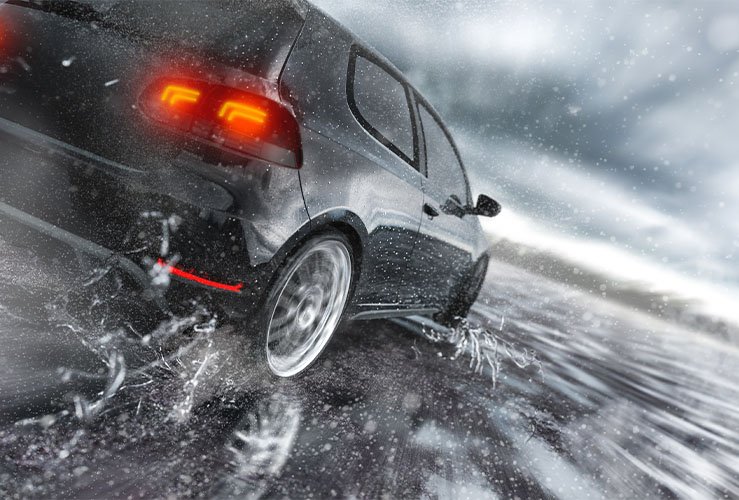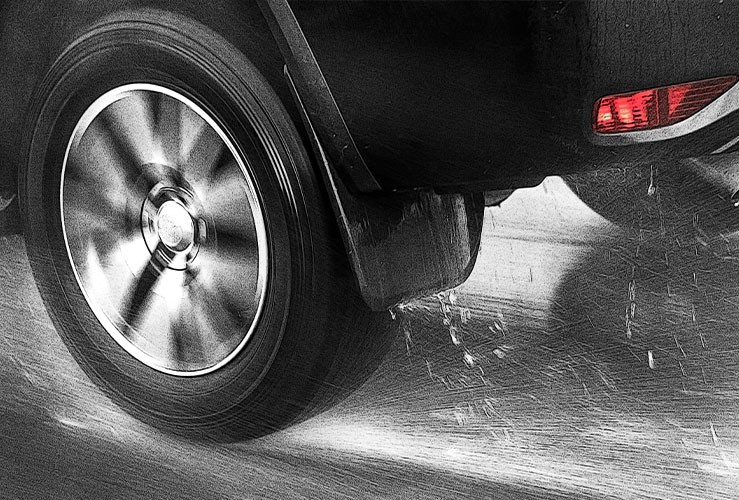Most UK drivers experience aquaplaning at some point - particularly if they live in western areas where rainfall is higher.
The experience of aquaplaning often produces a sudden surge of adrenaline as you realise you've lost control of your vehicle.
Thankfully, most instances of aquaplaning - while unsettling - are brief and don't put anyone in danger. But on a very flooded road aquaplaning can cause you to lose control.
To slide on a wet road can potentially result in a collision with another vehicle, street furniture or pedestrians.
With these risks in mind, it’s critical to understand what is aquaplaning in driving, how to act if you experience aquaplaning and how to minimise the chances of aquaplaning happening to you.

What is aquaplaning?
Aquaplaning occurs when you're driving on a wet surface and your tyres are unable to displace the rainwater.
Water collects at the front of the tyre, essentially lifting the tyre up - breaking contact with the road surface. And of course, without tyre-road contact, you are unable to control your vehicle.
What is hydroplaning?
Hydroplaning is another term used for aquaplaning. Essentially, aquaplaning and hydroplaning are the same thing.
Why does aquaplaning happen?
A combination of speed, tyre wear, tyre inflation and a build-up of water can all contribute to causing a car to aquaplane.
It’s not just heavy rainfall building up on a road’s surface that you need to be cautious of, pools of water where there are holes or ruts in a road can also cause aquaplaning.
Aquaplaning often occurs when tyre treads are excessively worn, making the tyre less effective at displaying water on the road.
Conversely, a car with newer, less worn tyres is likely to hold its grip much better.
How can you tell if your car is aquaplaning?
When driving on a wet road, there are various signs that you may experience that suggest your car may be aquaplaning:
- You may hear your engine suddenly become louder.
- You possibly feel like you’ve dropped the clutch down the gears while accelerating, causing the revs to increase.
- The steering may feel much lighter than usual due to a loss of grip.
- You may experience the back end of the car drifting from side to side – known as ‘fishtailing.’
Ineffectual braking and steering
With a layer of water between a car's tyres and the road surface, braking and steering will be substantially reduced - or completely ineffectual.

What to do if you aquaplane...
Once you’ve realised that your car has started to aquaplane it’s important to stay calm and focus on the road ahead:
- Don't hit the brakes or make big, sudden steering movements, as doing either could give you even less control and could cause you car to skid or slide into a collision.
- If you do need to brake, do so very gently and gradually.
- Grip the steering wheel tightly and in the direction you wish to go; only make very small steering movements.
- Ease off the accelerator pedal gently, until you have full control of the vehicle once again - You should be able to feel your wheels gaining traction as you gain back control of your car.
- At this point it is safe to make slow and steady movements of the steering wheel and gently use your brakes.
How to avoid aquaplaning? - Tips to avoid aquaplaning in the first place
Check your tyres
Inspect your tyres regularly and make sure that the tyre pressure is correct.
You should also ensure that your tyre’s tread depth is appropriate.
The legal minimum for tyre tread depth is 1.6mm but it’s much safer to have 3mm; this will give you better grip and dramatically reduce stopping distances.
Understand the driving conditions
You should always check the weather conditions before you drive, so you have an understanding of the driving conditions that you might encounter.
You’ll also be able to see and feel when the driving conditions change - Altering your driving technique according to the weather and road conditions can help to prevent incidents from happening, including helping to prevent your car from aquaplaning.
Watch your speed
As soon you notice the oncoming road is wet or that it has started raining, reduce your speed; you'll have a much better chance of regaining control compared to travelling fast
Remember, too, that stopping distances can double in wet conditions, so it’s important not to drive too fast and get too close to the vehicle in front.
Drive smoothly
As well as driving at a lower speed, you should also look to adopt a smooth driving technique when driving on wet roads.
Sudden and drastic changes in direction are not a good idea at the best of times, but especially not on wet roads.
Turn off your cruise control
If your car is fitted with cruise control, if the road is wet from recent rainfall or it's just started raining, turn off your cruise control, because this system can make maintaining a constant speed more difficult. (NB: using cruise control is also not advisable in snow, hail, sleet or ice.)
Follow the car tracks on the road
If you’re following a car in front then their tyres will often leave ‘tracks’ in the water.
These tracks are from where their tyres have already displaced some of the water;,
Following the track, at a safe distance from the car in front, can help to reduce your chances of aquaplaning.
Roads flooded?
Driving through flood water could cause costly or even irreparable damage to your vehicle, so should be avoided if you can.
However, if you do need to drive through flood water, our guide on how to drive through flood water will help you know what to do.




